 ISBN 978-1-57421-868-8
ISBN 978-1-57421-868-8
eISBN 978-1-60765-150-5 COPY PERMISSION: The written instructions, photographs, designs, patterns, and projects in this publication are intended for the personal use of the reader and may be reproduced for that purpose only. Any other use, especially commercial use, is forbidden under law without the written permission of the copyright holder. Every effort has been made to ensure that all information in this book is accurate. However, due to differing conditions, tools, and individual skills, neither the author nor publisher can be responsible for any injuries, losses, or other damages which may result from the use of the information in this book. INFORMATION: All rights reserved. All images in this book have been reproduced with the knowledge and prior consent of the artists concerned and no responsibility is accepted by producer, publisher, or printer for any infringement of copyright or otherwise, arising from the contents of this publication.
Every effort has been made to ensure that credits accurately comply with information supplied. WARNING: Due to the components used in this craft, children under 8 years of age should not have access to materials or supplies. Under rare circumstances components of products could cause serious or fatal injury. Neither New Design Originals, Suzanne McNeill, the product manufacturer, or the supplier is responsible. NOTE: The use of products and trademark names is for informational purposes only, with no intention of infringement upon those trademarks. eBook version 1.0 Acquisition editor: Peg Couch
Copy editors: Sue Kern, Laura Taylor
Cover and layout designer: Ashley Millhouse
Editor: Katie Weeber
Photographer: Scott Kriner Introduction: What is Macram?  Macram is the art of tying knots in cord or similar materials to create decorative items. eBook version 1.0 Acquisition editor: Peg Couch
Macram is the art of tying knots in cord or similar materials to create decorative items. eBook version 1.0 Acquisition editor: Peg Couch
Copy editors: Sue Kern, Laura Taylor
Cover and layout designer: Ashley Millhouse
Editor: Katie Weeber
Photographer: Scott Kriner Introduction: What is Macram?  Macram is the art of tying knots in cord or similar materials to create decorative items.
Macram is the art of tying knots in cord or similar materials to create decorative items.
It has a long history, likely originating with Arabic weavers, and has experienced popularity around the world at countless times in history. Both the United States and Europe experienced a macram craze in the 1960s and 1970s as it grew to be a popular craft. The most prevalent macram items, found in most homes, were the plant hanger and the macram owl, but other projects like lampshades, jewelry, clothes, and wall hangings were also popular. At the height of the trend, Vogue magazine produced a book on macram, bringing it into the world of high fashion. With all the different types of cord available on the market today, macram is again becoming popular as an incredibly versatile craft. Knot tying can be done with hundreds of different materials, from embroidery floss, ribbon, and yarn to hemp, cotton rope, and braided craft cord.
Furthermore, the range of macram projects is virtually endless. Thin embroidery floss can be combined with decorative knotting techniques to create delicate jewelry pieces, while thick rope can be combined with traditional marine knots to create functional items. This book takes advantage of sturdy craft cord to make home dcor and other items that will withstand everyday wear and tear. Whether youre looking for your next home dcor project or want a new fashion piece to add to your wardrobe, macram is sure to get you what you want. Pick a project and get started! 




 Getting Started Before you start work on a project, take some time to familiarize yourself with a few common techniques you will encounter throughout this book. These include basic knots and methods for splicing cords and wrapping cords neatly.
Getting Started Before you start work on a project, take some time to familiarize yourself with a few common techniques you will encounter throughout this book. These include basic knots and methods for splicing cords and wrapping cords neatly.
Basic Knots These simple knots will be used throughout the book to start or finish projects and to join two colors of cord together. Larks Head Knot  Overhand Knot
Overhand Knot  Square Knot
Square Knot  Reef Knot
Reef Knot  About Metric Throughout this book, youll notice that every measurement is accompanied by a metric equivalent. Inches and feet are rounded off to the nearest half or whole centimeter unless precision is necessary (note that some larger measurements are rounded off to the nearest meter). Please be aware that while this book will show 1 yard = 100 centimeters, the actual conversion is 1 yard = 90 centimeters, a difference of about 3 15/16 (10cm). Using these conversions, you will always have a little bit of extra cord if measuring using the metric system. [300cm] or longer) together is a great way to stay organized and keep the cord from tangling. [300cm] or longer) together is a great way to stay organized and keep the cord from tangling.
About Metric Throughout this book, youll notice that every measurement is accompanied by a metric equivalent. Inches and feet are rounded off to the nearest half or whole centimeter unless precision is necessary (note that some larger measurements are rounded off to the nearest meter). Please be aware that while this book will show 1 yard = 100 centimeters, the actual conversion is 1 yard = 90 centimeters, a difference of about 3 15/16 (10cm). Using these conversions, you will always have a little bit of extra cord if measuring using the metric system. [300cm] or longer) together is a great way to stay organized and keep the cord from tangling. [300cm] or longer) together is a great way to stay organized and keep the cord from tangling.
Use this quick and easy method to form an infinity bundle, which will keep your cord tangle free and accessible at all times.  Loop one end of the cord around your thumb on top of your palm. Bring the rest of the cord across your palm and pass it between your ring finger and pinky.
Loop one end of the cord around your thumb on top of your palm. Bring the rest of the cord across your palm and pass it between your ring finger and pinky.  Bring the working end of the cord around your pinky, across your palm, and around your thumb, forming a figure eight.
Bring the working end of the cord around your pinky, across your palm, and around your thumb, forming a figure eight.  Continue wrapping the cord around your pinky and thumb in a figure eight pattern until the working end measures 12"24" (30.561cm).
Continue wrapping the cord around your pinky and thumb in a figure eight pattern until the working end measures 12"24" (30.561cm). 
Next page

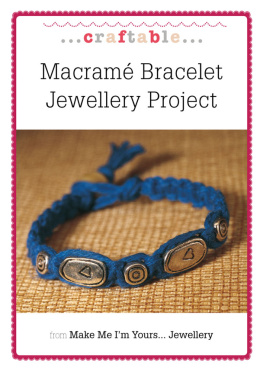
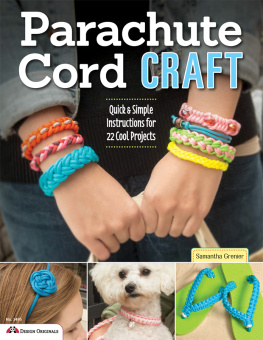
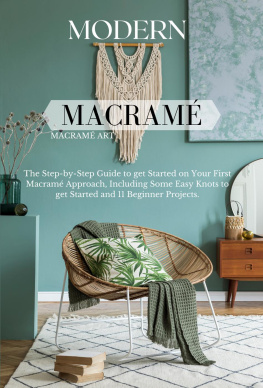
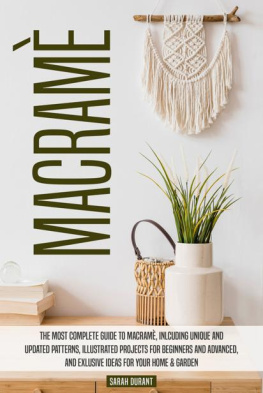
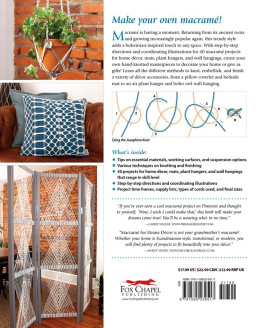
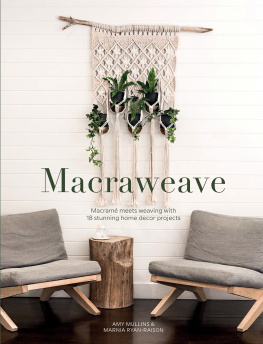
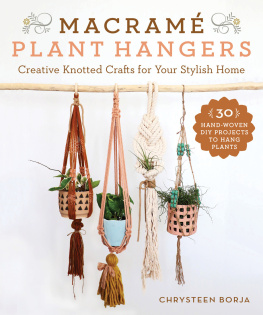

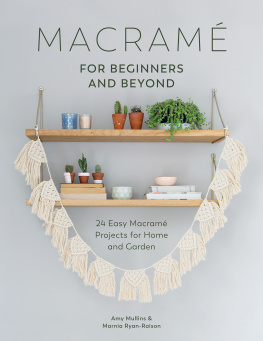

 ISBN 978-1-57421-868-8
ISBN 978-1-57421-868-8 Macram is the art of tying knots in cord or similar materials to create decorative items. eBook version 1.0 Acquisition editor: Peg Couch
Macram is the art of tying knots in cord or similar materials to create decorative items. eBook version 1.0 Acquisition editor: Peg Couch




 Getting Started Before you start work on a project, take some time to familiarize yourself with a few common techniques you will encounter throughout this book. These include basic knots and methods for splicing cords and wrapping cords neatly.
Getting Started Before you start work on a project, take some time to familiarize yourself with a few common techniques you will encounter throughout this book. These include basic knots and methods for splicing cords and wrapping cords neatly. Overhand Knot
Overhand Knot  Square Knot
Square Knot  Reef Knot
Reef Knot  About Metric Throughout this book, youll notice that every measurement is accompanied by a metric equivalent. Inches and feet are rounded off to the nearest half or whole centimeter unless precision is necessary (note that some larger measurements are rounded off to the nearest meter). Please be aware that while this book will show 1 yard = 100 centimeters, the actual conversion is 1 yard = 90 centimeters, a difference of about 3 15/16 (10cm). Using these conversions, you will always have a little bit of extra cord if measuring using the metric system. [300cm] or longer) together is a great way to stay organized and keep the cord from tangling. [300cm] or longer) together is a great way to stay organized and keep the cord from tangling.
About Metric Throughout this book, youll notice that every measurement is accompanied by a metric equivalent. Inches and feet are rounded off to the nearest half or whole centimeter unless precision is necessary (note that some larger measurements are rounded off to the nearest meter). Please be aware that while this book will show 1 yard = 100 centimeters, the actual conversion is 1 yard = 90 centimeters, a difference of about 3 15/16 (10cm). Using these conversions, you will always have a little bit of extra cord if measuring using the metric system. [300cm] or longer) together is a great way to stay organized and keep the cord from tangling. [300cm] or longer) together is a great way to stay organized and keep the cord from tangling. Loop one end of the cord around your thumb on top of your palm. Bring the rest of the cord across your palm and pass it between your ring finger and pinky.
Loop one end of the cord around your thumb on top of your palm. Bring the rest of the cord across your palm and pass it between your ring finger and pinky.  Bring the working end of the cord around your pinky, across your palm, and around your thumb, forming a figure eight.
Bring the working end of the cord around your pinky, across your palm, and around your thumb, forming a figure eight.  Continue wrapping the cord around your pinky and thumb in a figure eight pattern until the working end measures 12"24" (30.561cm).
Continue wrapping the cord around your pinky and thumb in a figure eight pattern until the working end measures 12"24" (30.561cm). 